Crusty Artisan Bread
This post may contain affiliate links. Read my full disclosure policy.
This crusty bread recipe is astonishingly easy—no kneading required—and makes three beautiful loaves, which you can bake as needed.
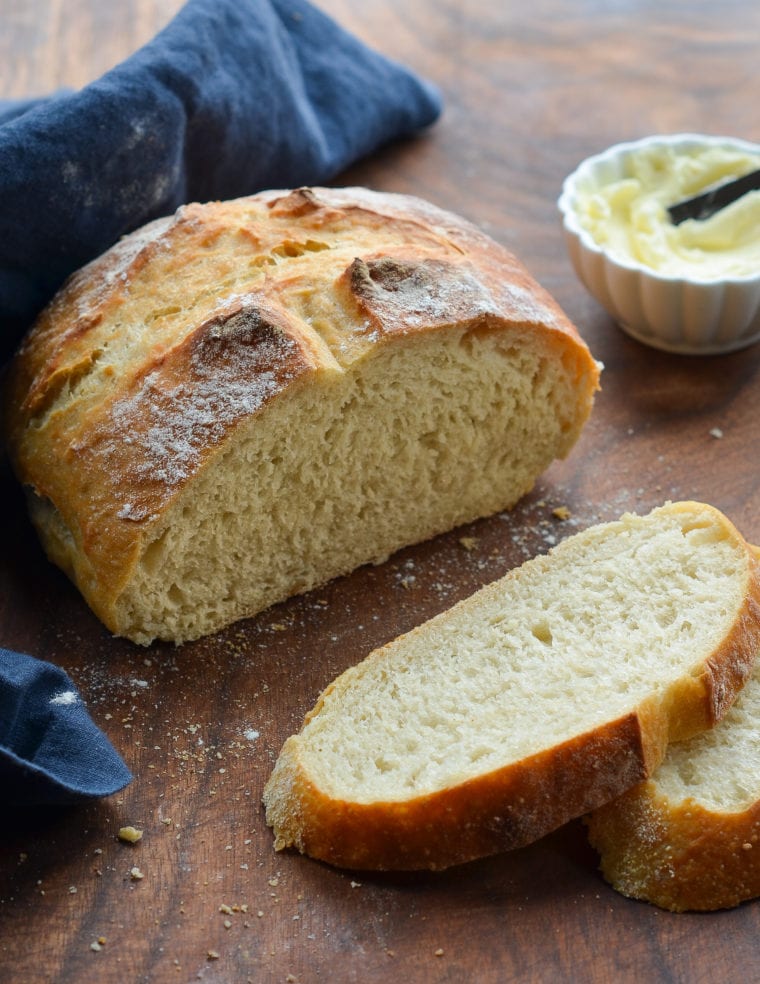
This homemade artisan bread recipe is astonishingly easy, and it makes enough for three delicious loaves, which you can bake as needed. What’s more, the dough takes just five minutes to make, does not require kneading or any special equipment, and can rest in the fridge for up to two weeks (the flavor becomes more complex the longer it sits). The recipe is modestly adapted from one of my favorite baking books, Artisan Bread in 5 Minutes A Day by Jeff Hertzberg M.D. and Zoë François.
Table of Contents
What You’ll Need To Make Crusty Artisan Bread
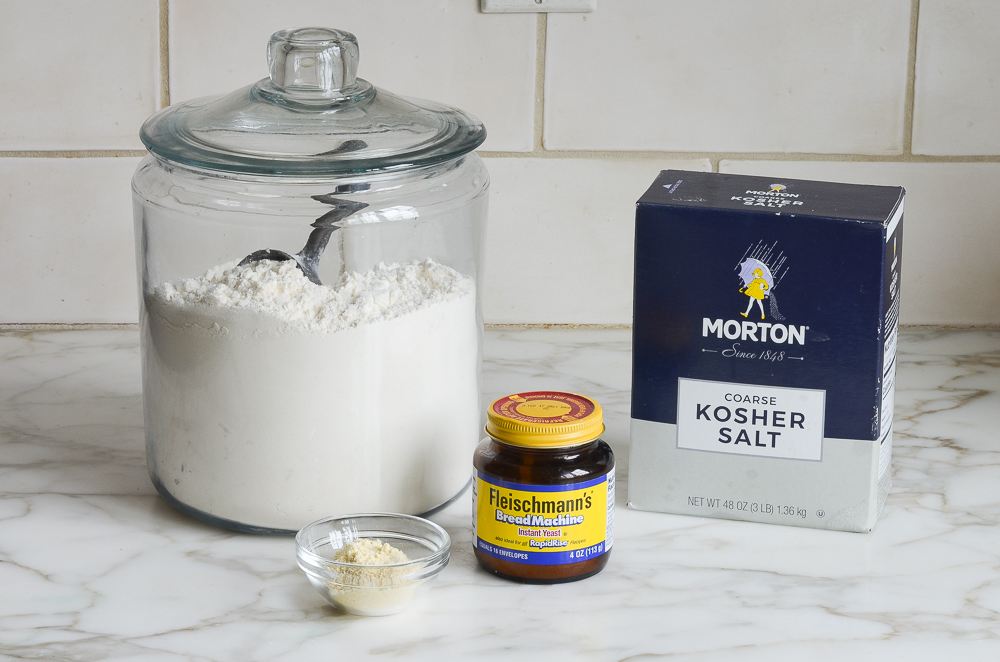
This recipe has just four ingredients: all-purpose flour, instant yeast, kosher salt, and water. (The cornmeal is for dusting the pan.) As you can see, I use instant (or rapid-rise) yeast. Active dry yeast may be used instead of instant yeast, however, the dough will take longer to rise. To give active dry yeast a boost, you can dissolve it in the lukewarm water and let it sit until frothy, about 10 minutes. After that, add it to the flour and proceed with the recipe.
How To Make Crusty Artisan Bread
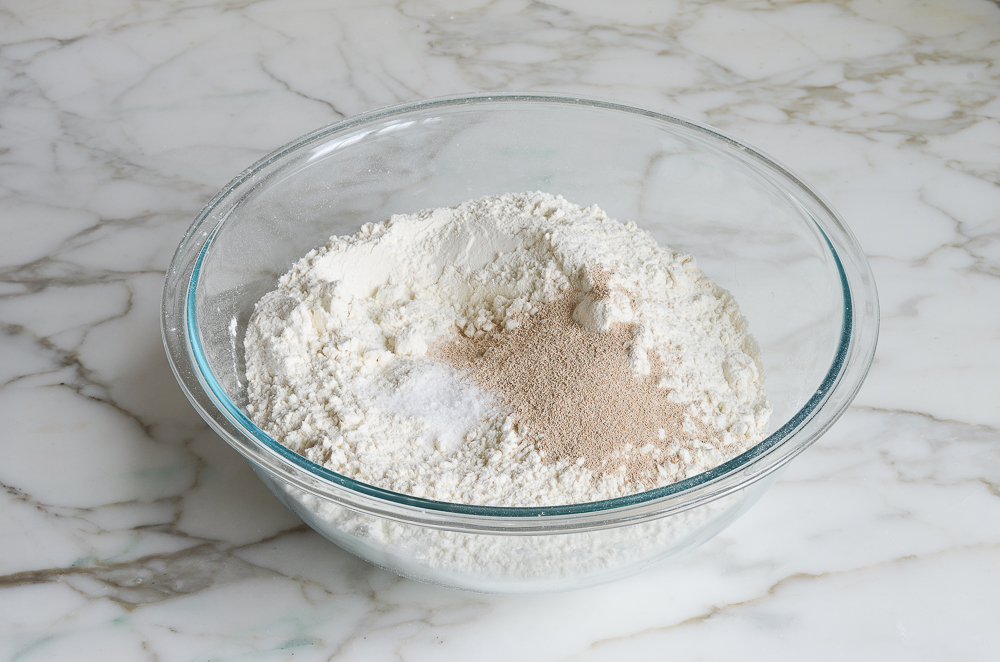
In a very large (6-quart) bowl, combine the flour, salt, and yeast. Mix to combine.
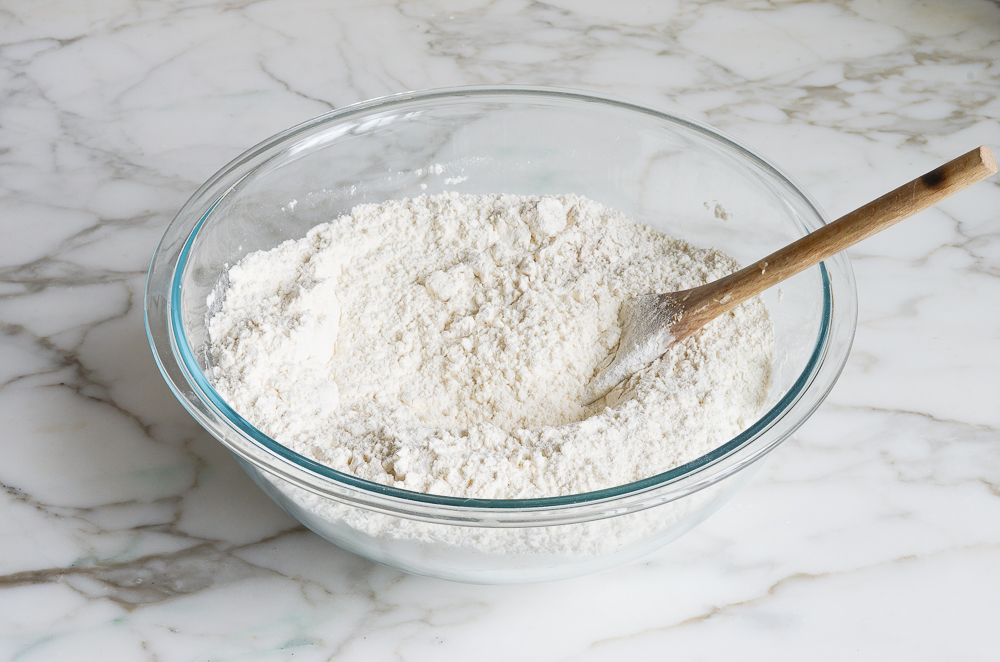
Add 3 cups of lukewarm water (no need to be exact but lukewarm is about 100°F).
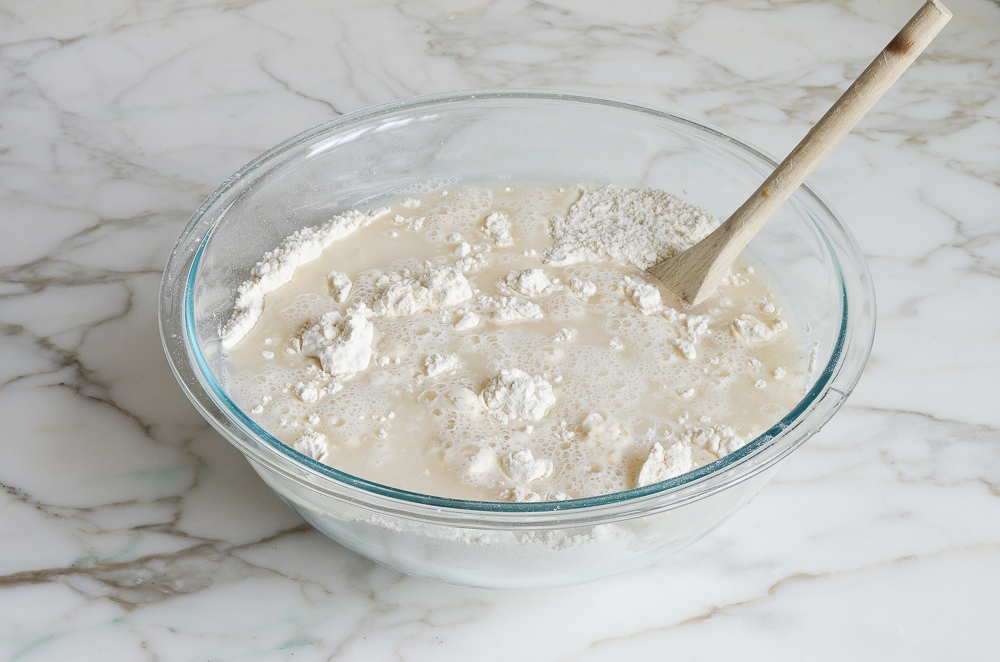
Stir with a wooden spoon until the mixture is uniformly moist, without any patches of flour.
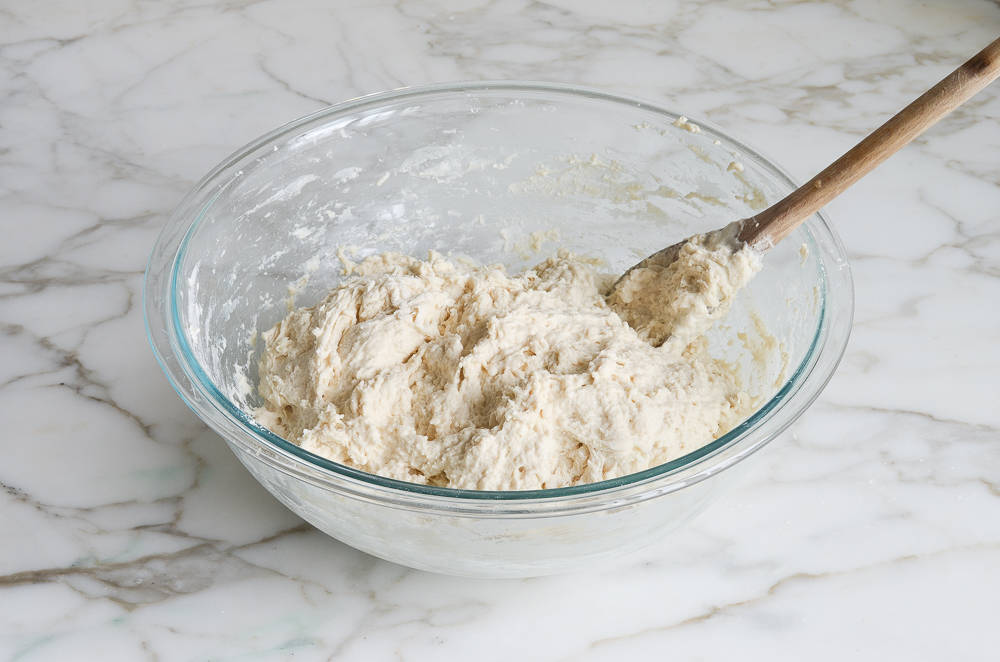
The dough should be sticky and conform to the shape of the bowl. If your dough is too dry, add a few tablespoons more warm water. If it’s too wet, add a few tablespoons of flour. Cover the bowl loosely with plastic wrap and let it sit on the counter in a warm spot for 2 hours. As you can see below, it will rise a lot!
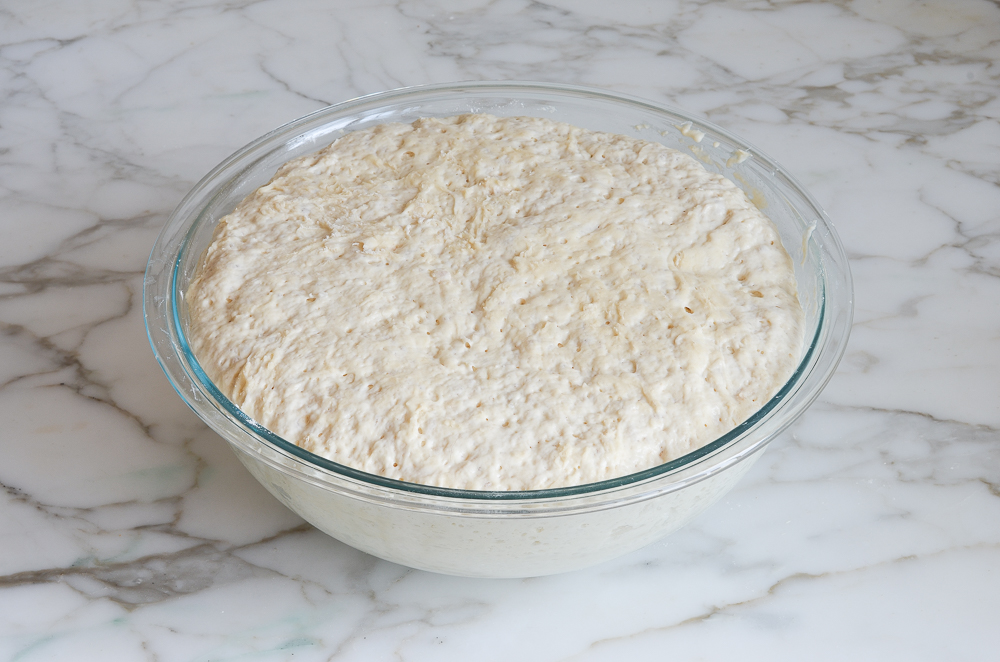
When you’re ready to bake a loaf, pull out one-third of the dough.
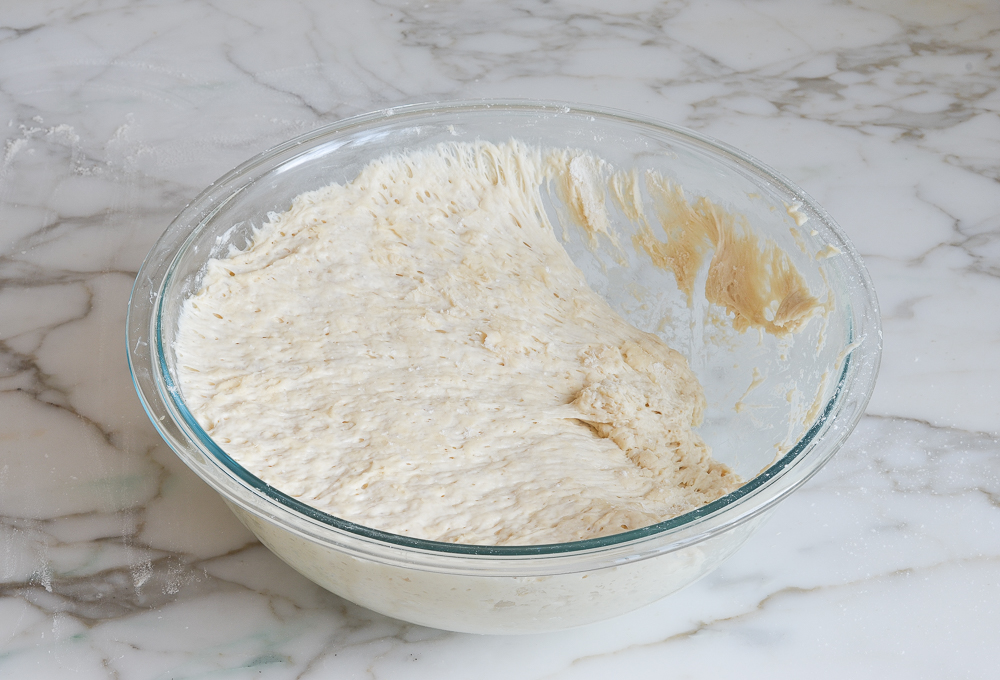
Coat the outside lightly with flour (you don’t want to incorporate more flour into the dough, you just want to be able to handle it). Gently work the dough into a smooth ball, stretching the surface and tucking the ends underneath.
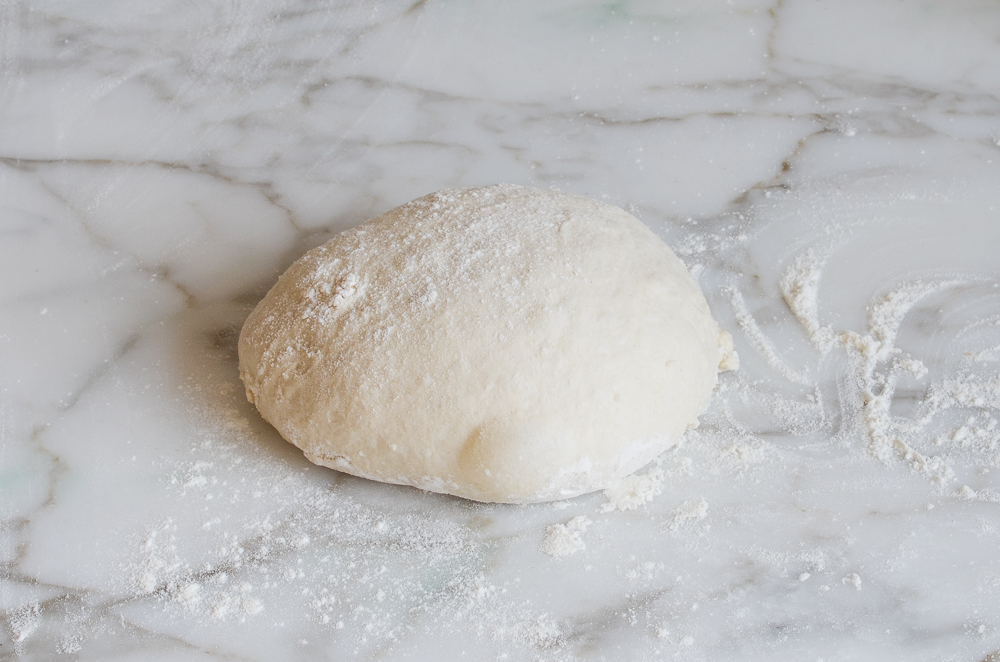
Put the dough ball onto a cornmeal-dusted baking sheet and let rest at room temperature, uncovered, for about 40 minutes. (If the dough has been refrigerated, allow it to rise for 60 minutes, or up to 90 minutes if you want a more open and airy crumb structure.) The dough will rise a bit. It may also spread/flatten a bit; that’s okay.
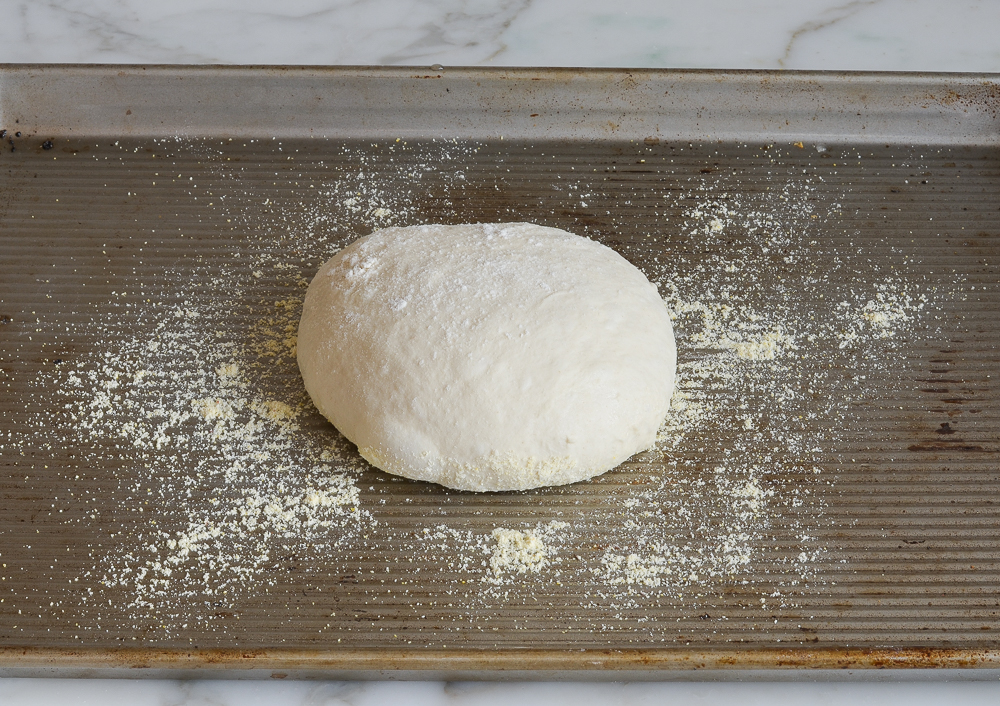
The dough will rise a bit.
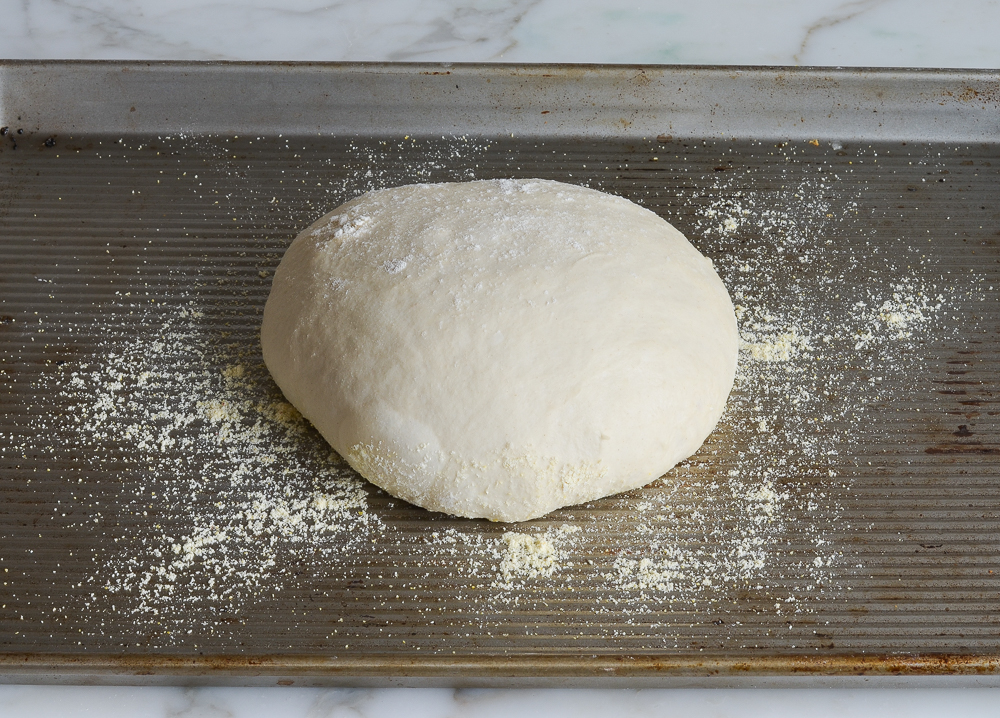
Generously dust the dough with flour. Using a sharp knife, make a few 1/2-inch-deep slashes in the dough — a scallop, cross, or tic tac toe pattern all look nice.
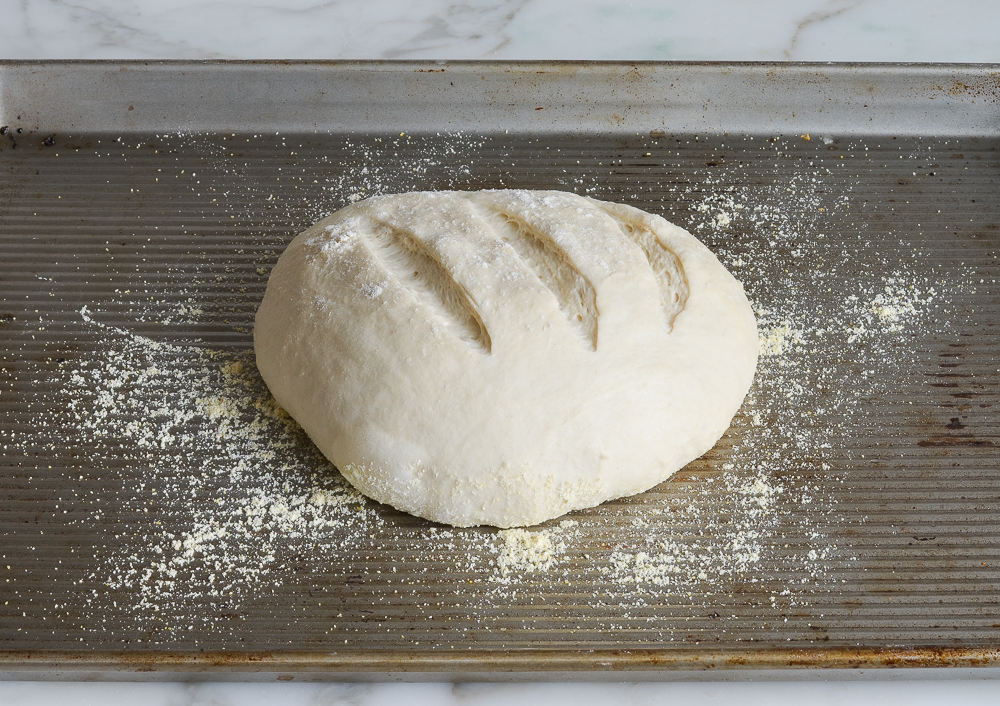
Set a metal pan on the bottom rack of a preheated 450°F-oven. Slide the baking sheet with the dough into the oven, and carefully fill the metal cake pan with one cup of hot tap water. This creates steam in the oven. (Try to do this quickly so as not to let heat out of the oven.) Bake until the loaf is golden brown, about 30 minutes. Cool completely on a wire rack.
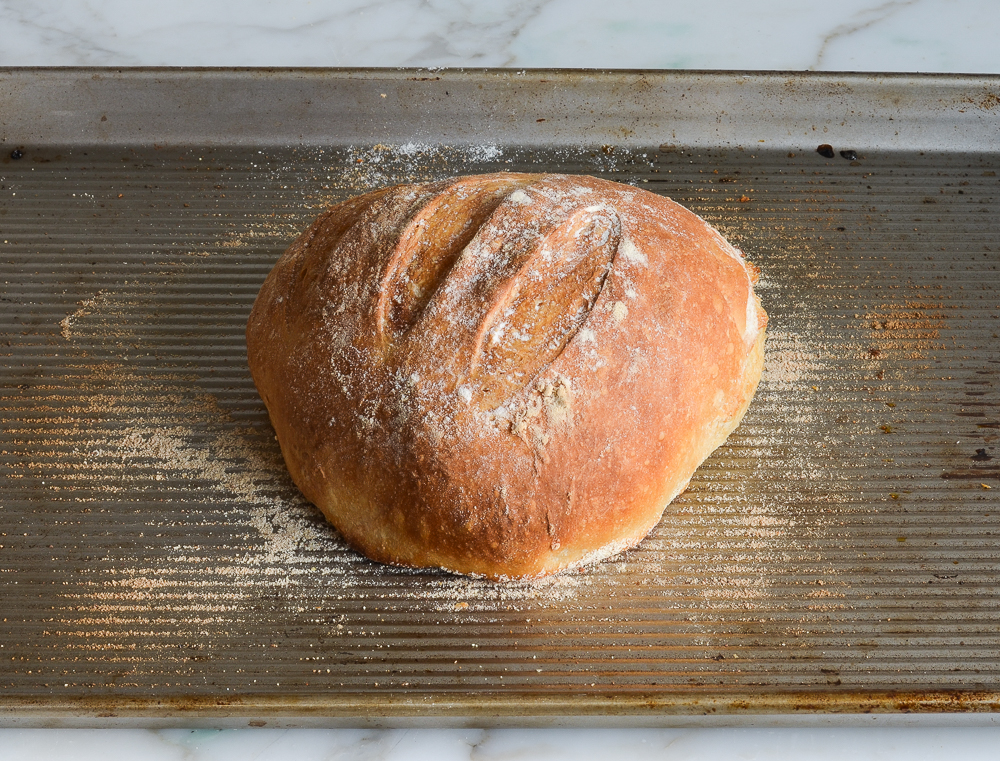
This bread is best enjoyed fresh on the day it is made. Once sliced, place the loaf cut-side down on a cutting board or plate and leave it uncovered.
How To Freeze
The dough can be portioned into thirds and frozen in airtight plastic containers for up to 1 month. Defrost the dough in the refrigerator overnight, then shape, rest and bake as usual. The baked loaves can also be frozen whole or sliced. Wrap in a zip-top freezer bag and freeze for up to 1 month. To thaw, take the bread out of the freezer and let it come to room temperature, about 3 hours. Reheat in a 350°F oven until warmed through, about 10 minutes.
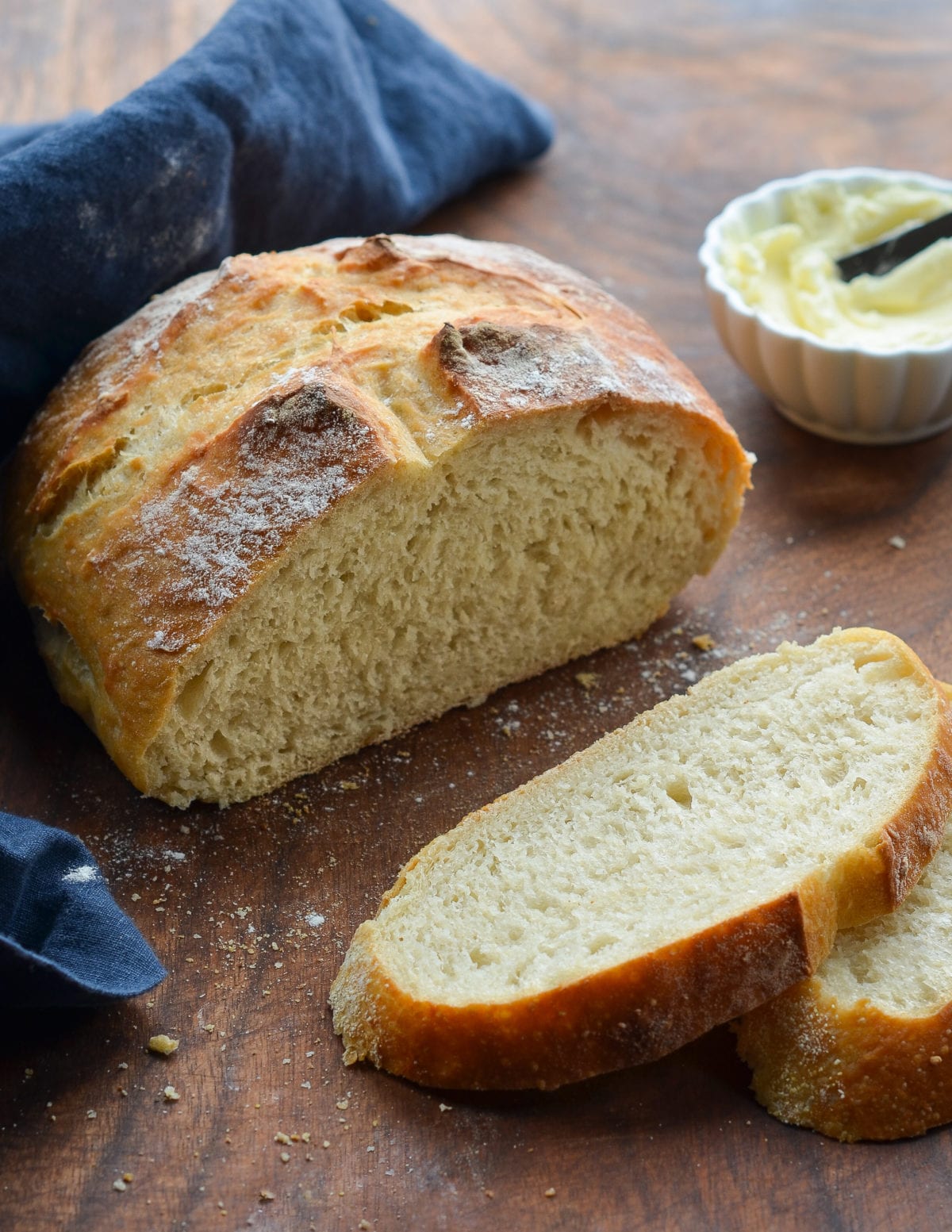
You May Also Like
Crusty Artisan Bread
This crusty bread recipe is astonishingly easy—no kneading required—and makes three beautiful loaves, which you can bake as needed.
Ingredients
- 6½ cups all-purpose flour, spooned into measuring cup and leveled-off (preferably King Arthur; see note)
- 4 teaspoons kosher salt
- 1½ tablespoons instant/rapid-rise yeast (see note)
- 3 cups lukewarm water (no need to be exact but lukewarm is about 100°F)
- Cornmeal, for dusting the pan
Instructions
- In a very large (6-quart) bowl, whisk together the flour, salt, and yeast. Add the water and stir with a wooden spoon until the mixture is uniformly moist, without any patches of flour. The dough should be sticky and conform to the shape of the bowl. If your dough is too dry, add a few tablespoons more warm water. If it's too wet, add a few tablespoons of flour. (See the step-by-step photos for guidance on what the dough should look like.) Cover the bowl loosely with plastic wrap and let it sit on the counter in a warm spot for 2 hours. If you plan to bake a loaf immediately, proceed to the next step. Otherwise, place the bowl of dough in the refrigerator to be used over the next 14 days. (Once refrigerated, the dough will shrink back a bit; that's okay. Do not punch down the dough at any point, and keep it loosely covered with plastic wrap.)
- Dust a sturdy baking sheet with cornmeal.
- Dust the surface of the dough and your hands lightly with flour. Pull out one-third of the dough and coat the outside lightly with flour (you don't want to incorporate more flour into the dough, you just want to be able to handle it). Gently work the dough into a smooth ball, stretching the surface and tucking the ends underneath, adding more flour as needed so it doesn't stick to your hands. (Don't overwork the dough; this process should only take about 30 seconds.) Put the dough ball onto the prepared baking sheet and let it rest at room temperature, uncovered, for about 40 minutes. (If the dough has been refrigerated, allow it to rise for 60 minutes, or up to 90 minutes if you want a more open and airy crumb structure.) The dough will rise a bit. It may also spread/flatten a bit; that's okay.
- Preheat the oven to 450°F. Set one rack in the lowest position of the oven and one rack in the middle position. Place a metal pan (any metal cake pan or broiler pan will work; just don't use glass) on the bottom rack. (You will fill this with water later to create steam in the oven).
- Generously dust the dough with flour. Using a sharp knife, make a few ½-inch-deep slashes in the dough -- a scallop, cross, or tic tac toe pattern all look nice.
- Slide the baking sheet with the dough into the oven, and carefully fill the metal cake pan with one cup of hot tap water. (Try to do this quickly so as not to let heat out of the oven.) Bake until the loaf is golden brown, about 30 minutes. Cool completely on a wire rack.
- This bread is best enjoyed fresh on the day it is made. Once sliced, place the loaf cut-side down on a cutting board or plate and leave it uncovered. (If it lasts beyond a day, I suggest slicing and freezing.)
- Freezer-Friendly Instructions The dough can be portioned into thirds and frozen in airtight plastic containers for up to 1 month. Defrost the dough in the refrigerator overnight, then shape, rest and bake as usual. The baked loaves can also be frozen whole or sliced: Wrap in a zip-top freezer bag and freeze for up to 1 month. (If you plan to use slices one at a time, place pieces of parchment between them so they don't stick.) To thaw, take the bread out of the freezer and let it come to room temperature on the countertop. Reheat in a 350°F oven until warmed through, about 10 minutes.
- Note: Active dry yeast may be used instead of instant/rapid-rise yeast, however, the dough will take longer to rise. To give active dry yeast a boost, you can dissolve it in the lukewarm water and let it sit until frothy, about 10 minutes. After that, add it to the flour and salt, and proceed with the recipe.
- Note: I use King Arthur flour, which is higher in protein than some other all-purpose flours. If using a flour with a lower protein content, such as Gold Medal, you will likely need to add a few more tablespoons of flour.
Nutrition Information
Powered by ![]()
- Serving size: 1 slice
- Calories: 100
- Fat: 0 g
- Saturated fat: 0 g
- Carbohydrates: 21 g
- Sugar: 0 g
- Fiber: 1 g
- Protein: 3 g
- Sodium: 64 mg
- Cholesterol: 0 mg
This website is written and produced for informational purposes only. I am not a certified nutritionist and the nutritional data on this site has not been evaluated or approved by a nutritionist or the Food and Drug Administration. Nutritional information is offered as a courtesy and should not be construed as a guarantee. The data is calculated through an online nutritional calculator, Edamam.com. Although I do my best to provide accurate nutritional information, these figures should be considered estimates only. Varying factors such as product types or brands purchased, natural fluctuations in fresh produce, and the way ingredients are processed change the effective nutritional information in any given recipe. Furthermore, different online calculators provide different results depending on their own nutrition fact sources and algorithms. To obtain the most accurate nutritional information in a given recipe, you should calculate the nutritional information with the actual ingredients used in your recipe, using your preferred nutrition calculator.

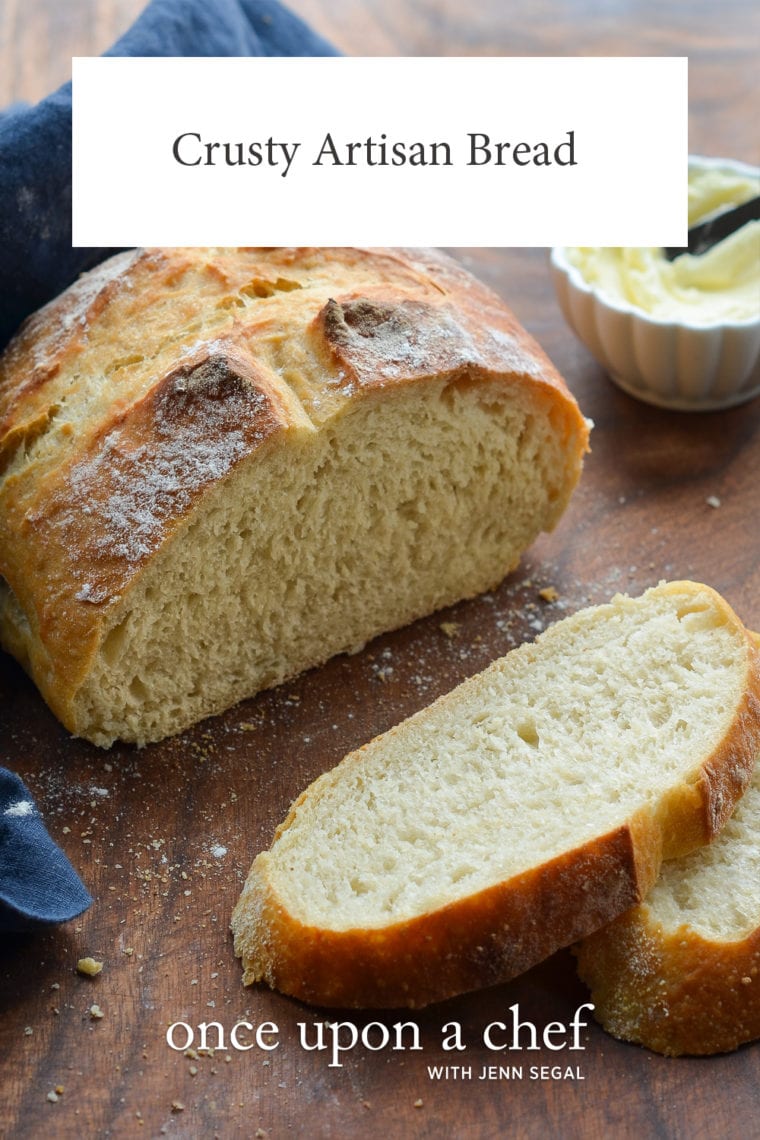
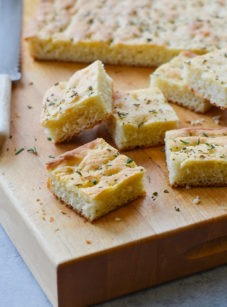
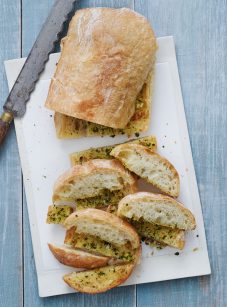
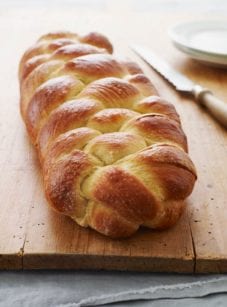
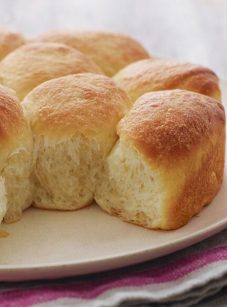
I love your recipes and how you’ve made them so foolproof. When I baked the refrigerated dough a few days later, the bread had a different taste. Hard to describe but maybe more fermented or yeasty? Didn’t favor it as much as the bread baked on the day the dough was made. Is this normal or am I missing something? Thank you for your help!
So glad you enjoy the recipes, Josephine! That yeasty flavor is completely normal; it becomes stronger the longer the dough sits.
So so good! I baked bread for the very first time and was almost certain that it would be somewhat of a disaster; I was proven wrong! It was delicious!!! Every recipe by you has been a hit! Thanks for sharing these recipes! Xo
This is the best and most successful bread recipe that I’ve ever tried. Can you bake two loaves at the same time? Do you need to double the water in a single pan, or put in water in two separate pans?
Hi Chinette, So glad you had success with the recipe! You can definitely bake two loaves at once; no need to double the water.
My brother is impossible to please, he never likes what I cook! When I made this though, he ate a full loaf and said this was the best bread he’s ever had. Will 10/10 be making this again.
Hi Jenn,
We enjoy this bread several times a week. Would it work to incorporate fresh herbs into the recipe? I’m growing oregano and rosemary, and am wondering if you think they would be a good addition.
Thanks so much for this and all your other delicious recipes!
Max
Hi Max, I think it’d work nicely!
I added some finely chopped fresh rosemary and oregano from my backyard to the mix. Delicious! May try some roasted garlic next time.
I’m not really a baker, and I’m horrible with recipes, but this bread turned out so wonderful, and it’s so simple! Even I didn’t mess it up! Thank you!
This recipe is amazing! My 12 year old found this recipe. She’s been very intersted in baking lately. Once I was able to find yeast, I let her take over the kitchen. She made this bread ALL BY HERSELF. She followed the directions as stated. The bread came out perfectly. Our family of 4 went through one loaf within hours of coming out of the oven. The other 2 loaves didn’t last more than a couple days. She made six more loaves to hand out to family. I even bought her artisan bread bags from amazon to gift in. Family and neighbors could not believe this was not store bought (it looks really beautiful) and that I did not help her. My daughter refuses to give out the recipe since she enjoys baking it. She also decided to get creative and add jalapenos and cheddar to the dough… SO GOOD! When it gets cooler out, I plan on asking her to make smaller loaves to use as bread bowls for soups. She also wants to collaborate with her great grandma to make Christmas baskets for the family. She will make the bread, then she will help her great grandma make garlic butter and jams to include.
So glad this has been such a hit and that your 12 year old has been keeping busy in the kitchen! 🙂
This is a great recipe!! Curious as to why it needs to be stored unwrapped, cut side down.
Glad you like it. Keeping it stored like that helps to keep the crust a bit crispy (and the cut-side down is to keep that end piece from getting stale).
I halved the recipe as written to make a larger loaf. My dough was extremely sticky and I had trouble forming into a round loaf. I might of added another 1/4 cup of King Arthur’s. When it was ready to go in the oven it had spread considerably giving me doubts it would be good. After cooling down a bit, I cut a slice….the taste was good and the crust crispy. I should note, I’m in S.Carolina, the temp outside was 94 and inside 79 which could have contributed to not rising enough. It did make wonderful toast!
The best bread recipe I’ve come across… delicious! Just wondering if anyone has baked this in a traditional loaf tin (for a more sandwich-friendly shape)?
Addition… made first third into a round loaf – lasted a day. Remaining dough sat in the fridge for 3 days and shortly after I asked the above question, I cracked and baked it in my large loaf pan. It worked brilliantly… admittedly small but lovely square-ish slices.
I’m not entirely sure where the problem lies with this recipe but it has been nothing but a gooey, sticky mess on both occasions I have tried to bake it. It was still edible in the end but really frustrating. Instructions & measurements were followed precisely. If this recipe only works with King Arthur flour that would be wise to advise readers of.
I’m sorry you’ve struggled with this so much! While I always get great results with King Arthur flour, it’s not mandatory to use in this recipe. May I ask what brand of flour you used?
Hi Jenn,
I made this recipe with KA flour and it came out perfectly- all three loaves were great. Sadly KA is not to be found at my local grocer so I bought the store brand. The bread was a gooey, sticky mess. I added more flour and put it in the fridge for a few days. Eventually I baked it and it was fine but not even close to the perfect loaves I got with KA flour. I think your recipe is a winner but store brand flour stinks!
Sorry you had a problem with the store’s flour! While some brands are better than others, I consistently have good luck with King Arthur!
Thank you for this recipe, Jenn. My 14 year old grandson has become interested in baking and said he wanted to try making bread… I had just made this and thought it was the perfect recipe to start him off on. We worked on it together, had a ball and he was proud to treat everyone with his delicious homemade bread. Thank you for being the catalyst for memory making! I hope he always remembers making his first loaf of bread with his Grandmother. (Next on his wish list: braided multicolor challah bread)
❤️
I have made this recipe several times, great!! Could you make a pizza from this recipe?
So glad you like it! While it may be possible, I have a recipe for pizza dough that I’d suggest you try instead. 🙂
So easy. Tastes great. Works well because I have enough dough for 3 mini loaves. I can keep in the fridge and can bake fresh and eat the loaf the same day.
Can’t believe how easy this was to make and how perfect it came out! My husband and daughter were waiting with butter in hand to slather onto this hot, crispy, pillowy, chewy ball of comfort! Soooo good! Hot bread and butter on a Saturday afternoon.
I have your book and I have made so many recipes off of your site and I never alter anything! Unbelievable! You have a gift for cooking! Keep them coming!
❤️